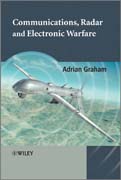
INDICE: Preface. Glossary. PART ONE BASIC THEORY. 1 Introduction. 1.1 The Aim of this Book. 1.2 Current Radio Technology. 1.3 Factors Constraining Radio Communications. References and Further Reading. 2 Management of the Radio Spectrum. 2.1 Spectrum Management Fundamentals. 2.2 Civil Spectrum Management. 2.3Military Spectrum Management. 2.4 Management of EWActivities. References and Further Reading. 3 The Radio Channel. 3.1 Frequency Aspects of the Radio Channel. 3.2 Narrowband Signals. 3.3 Frequency Hopping Signals. 3.4 Wideband Signals. 3.5 The Effect of Movement on the Radio Channel. References and Further Reading. 4 Radio Links in the Presence of Noise. 4.1 Sources of Radio Noise. 4.2 Effects of Noise. 4.3 The Radio Receiver. 4.4 Radio Link Budgets in the Presence of Noise. References and Further Reading. 5 Radio Links in the Presence of Interference. 5.1 Sources of Radio Interference. 5.2 Interference in the Spectral Domain. 5.3 Interference in the Time Domain. 5.4 Interference Mitigation Techniques. References and Further Reading. 6 Radio Links and Deliberate Jamming. 6.1 The Purpose of Jamming. 6.2 How Jamming Works. 6.3 Types of Communications Jammers. 6.4 Jamming Mitigation Techniques. References and Further Reading. 7 Radar and Radar Jamming. 7.1 Introduction to Radars. 7.2 The Radar Equation. 7.3 Types of Radar. 7.4 Radar Jamming Techniques. 7.5 Radar Jamming Mitigation Techniques. References and Further Reading. 8 Radio-Controlled Improvised Explosive Devices. 8.1 The Poor Mans Weapon of Choice: IEDs. 8.2 Radio Controlfor IEDs. 8.3 Detection of IED Radio Control Systems. References and Further Reading. PART TWO PRACTICAL. 9 Predicting HF Radio. 9.1 Propagation at HF. 9.2HF Skywave Link Budgets. 9.3 Groundwave. References and Further Reading. 10 VHF to SHF Radio Prediction. 10.1 Propagation above HF. 10.2 Modelling Methods.10.3 Deterministic Models. 10.4 Empirical Models. 10.5 Combined Models. 10.6 Link Budgets. References and Further Reading. 11 Data Requirements for Radio Prediction. 11.1 Why Consider Modelling Requirements? 11.2 Communications System Parameters. 11.3 ES Specific Parameters. 11.4 EA Specific Parameters. 11.5 Radar Specific Parameters. 11.6 Third-Party Characteristics. 11.7 General Antenna Characteristics. 11.8 Antenna Environment Considerations. 11.9 Terrain Data. 11.10 Ground and Radio Clutter Data. 11.11 Sunspots, Ionospheric and Atmospheric Data. References and Further Reading. 12 Planning and Optimising Radio Links. 12.1 Path Profile Prediction. 12.2 Optimising a Link. 12.3 Re-Broadcast Links. 12.4 Linked Networks. References and Further Reading. 13 Planning Radio Networks for Coverage. 13.1 Coverage Predictions. 13.2 Optimisation of Radio Networks. 13.3 Limiting Coverage. References and Further Reading. 14 Interference Analysis. 14.1 Int
- ISBN: 978-0-470-68871-7
- Editorial: John Wiley & Sons
- Encuadernacion: Cartoné
- Páginas: 400
- Fecha Publicación: 07/01/2011
- Nº Volúmenes: 1
- Idioma: Inglés
